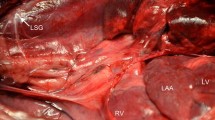Summary
The autonomic irritation from the digestive organs and the urinary tract influences upon the cardiac function. Using the electrophysiological technique, this mechanism was revealed.
-
1.
The authors presented two patients with arrhythmia, the one suffering from dysuria and the other suffering from cholelithiasis. These arrhythmias appeared with overdistension of the urinary bladder and operative procedure, and disappeared promptly by urination and cholecystectomy.
-
2.
Experimental overdistension of the urinary bladder in dogs, rabbits and guinea pigs resulted in transitory fall of blood pressure, pictures of coronary insufficiency in EKG and/or appearance of arrhythmias. These changes disappeared by relieving the bladder of overdistension.
-
3.
In guinea pigs it was shown that the EKG changes produced by overdistension of the urinary bladder were erased by transection of the spinal cord between the lumbo-sacral segment.
-
4.
Electrophysiological study showed that the nervous transmission from the bladder wall to the heart was related to, vago-vagal reflex.
-
5.
It was known that the irritation of the gallbladder and gastro-enterical tract sometimes produced the myocardial changes.
This mechanism was revealed by the result that arrhythmia or EKG changes appeared at the same time when electrical response of vago-vagal reflex was increased after irritation of the gall-bladder or the pyloric region.
Zusammenfassung
Die autonomische Irritation der Verdauungsorgane und des Harnweges hat auf die Herzfunktion einen Einfluß. Durch die elektrophysiologische Technik wurde dieser Mechanismus aufgeklärt.
-
1.
Es wurde an zwei Patienten mit Arrhythmie, von denen der eine an Dysurie und der andere an Cholelithiasis leidet, gezeigt, daß diese Arrhythmie, die durch die Überdehnung der Harnblase und durch die Operation ausgelöst war, sofort nach dem Urinieren und der Cholecystektomie wieder verschwand.
-
2.
Bei der experimentellen Überdehnung der Harnblase des Hundes, des Kaninchens und des Meerschweinchens trat vorübergehender Abfal des Blutdruckes, Koronarinsuffizienz im EKG und/oder Arrhythmie auf. Diese Veränderungen verschwanden nach dem Urinieren.
-
3.
Es wurde am Meerschweinchen gezeigt, daß die durch die Überdehnung der Harnblase verursachten EKG-Veränderungen durch eine Rückenmarksdurchschneidung im lumbosakralen Segment plötzlich verschwanden.
-
4.
Elektrophysiologische Untersuchungen zeigten, daß die neurale Transmission von der Harnblasenwand zum herz im Zusammenhang mit dem Vago-vagal-Reflex steht.
-
5.
Es ist bisher bekannt, daß die Irritation der Gallenblase und des Verdauungsorganes bisweilen Myokardveränderungen verursacht. Dieser Mechanismus ließ sich dadurch beweisen, daß die Arrhythmie oder die EKG-Veränderungen zur gleichen Zeit wie die gesteigerte elektrische Reaktion des Vago-vagal-Reflexes, nach Irritation der Gallenblase oder Pylorusregion auftraten.
Résumé
-
1.
Chez deux patients atteints de rétention urinaire de causes différentes, on a observé pendant la dilatation de la vessie une arythmie, qui disparaît promptement lorsque l'on vide la vessie par sondage.
-
2.
La dilatation expérimentale de la vessie chez l'animal produit une chute transitoire de la pression artérielle, des signes d'insuffisance coronaire dans l'ECG avec arythmie, ou de l'arythmie seule. Ces troubles disparaissent lorsque la vessie est vidée.
-
3.
Chez le cobaye, on a montré que les altérations de l'ECG produites par dilatation de la vessie disparaissent après section de la moelle entre les segments lombaire et sacré.
-
4.
Chez le lapin, on a constaté que l'irritation de la vésicule biliaire ou du pylore influence l'ECG par réflexe vago-vagal.
-
5.
L'emploi, d'une technique électrophysiologique a permis de montrer que la transmission nerveuse des parois de la vessie, de la vésicule biliaire ou du pylore au coeur se fait par réflexe vago-vagal.
Similar content being viewed by others
References
Ohmori, K., Yamaguchi, M. Tsuchiya and coll., Jap. J. Int. Med., Vol. 48, No. 5, 1959.
Reilly, J., F. Darnis, E. Rivalier, P. Tournier, H. Du Buit, M. Tsuchiya andM. L. Delorme, Rev. Int. Hepat.9 (1959), 8.
Sugaya, E., Symposium on Neurovegetativum, Basel, 1964.
Gilbert, N. C., G. K. Fenn andG. V. LeRoy, J. Amer. Med. Ass.115 (1940), 1962.
Levy, R. L., H. G. Bruen andN. F. Williams, Amer. Heart J.19 (1940), 639.
Schwartz, M., andA. Hermann, Ann. Int. Med.18 (1942), 83.
Fitz-Hugh, T. J., andC. C. Wolferth, Ann. Surg.101 (1935), 478.
McArthur, S. W., andH. Wakefield, J. Laborat. Clin. Med., S. Louis,30 (1945), 349.
Hodge, G. B., andA. L. Messer, Surg. Gyn. Obstetr.86 (1948), 617.
Walter, B., andA. M. Master, Surg. Gyn. Obstetr.94 (1952), 152.
Gilbert, N. C., Bull. N. Y. Acad. Med.18 (1942), 83.
Bergmann, von, Dtsch. med. Wschr.58 (1932), 605.
Coggins, C. H., G. A. Lillington andC. P. Gray, Arch. Int. Med., Chicago.1 (1964), 64.
Lukash, W. M., G. T. Sawyer andJ. E. Davis, N. England J. Med.270 (1964), 341.
Taylor, D. E. M., Lancet1963, 1033.
Kuru, M., Proc. Jap. Acad.29 (1953), 230.
Kuru, M., J. Physiol.4, (1954), 173.
Reilly, J., E. Revalier, A. Compagnon andR. Laplane, Compt rend. Soc. biol., Paris,116 (1934), 24.
Yamaguchi, Y., M. Tsuchiya, T. Akiba andK. Shiraishi, Keijo J. Med.9 (1960), 91.
Yamaguchi, Y., M. Tsuchiya, T. Akiba, M. Yasuda, Y. Kiryu, T. Hagiwara, Y. Fujishiro andE. Sugaya, Keijo J. Med.13 (1964), 87.
Author information
Authors and Affiliations
Additional information
With 8 Figures
Rights and permissions
About this article
Cite this article
Yamaguchi, Y., Tsuchiya, M., Akiba, T. et al. Action of autonomic nervous reflex arising from visceral organs upon the heart. Acta Neurovegetativa 28, 224–233 (1966). https://doi.org/10.1007/BF01227383
Issue Date:
DOI: https://doi.org/10.1007/BF01227383




